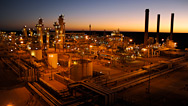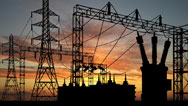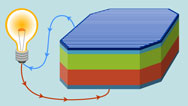Green Energy in China
- Posted 04.14.11
- NOVA
Industrial growth across China is staggering. The nation is adding the equivalent of a city the size of Chicago every three months. To meet skyrocketing demands for energy, China is becoming a leader in the production of solar technology and the development of smart electric grids. In this video, get a glimpse of the efforts underway.
Transcript
Green Energy in China
Posted: April 14, 2011
NARRATOR: Today some Americans are trying to get back into the solar game and Charlie Gay of the California based company Applied Materials is here in Xi'an, China to prove it.
CHARLIE GAY: I love Xi'an—it's a great city. This is the Asian end of the Silk Road.
NARRATOR: But is it business, not pleasure or even the nightly musical fountains, that makes Gay travel to China.
GAY: There are a lot of people out mining for gold. They are building solar factories everywhere.
NARRATOR: Applied Materials, a star company of Silicon Valley, now makes the machines that make the solar panels for this new gold rush.
GAY: We're in the business of selling shovels to the gold miners.
NARRATOR: In China, that means doing business the old fashioned way—amidst a flurry of firm handshakes.
GAY: We look forward to great opportunity to create a bright future.
NARRATOR: And it means developing cutting-edge technologies. Last year Applied Materials opened this new R and D plant in China. Larger than four football fields, it is the biggest non-governmental solar energy research facility in the world.
Here, they push their panels to the extreme—baking them in ovens, flooding them with light, and when they survive all that, battering them with hail.
But the biggest thing in their arsenal is cutting costs, and Applied Materials is developing new says to do that by cutting down on the amount of expensive silicon used.
GAY: We cut thinner wafers out of this big block of silicon. The way that we cut the silicon is to use wire. This is not a lot different than ancient Egyptians cutting stone to make pyramids.
NARRATOR: The low cost of labor—in ancient Egypt or modern China—is, of course, another way of getting costs down. And while solar manufacturing is not labor intensive, the 200 engineers that work here cost one-fifth what they would in the U.S.
GAY: When we advertised for engineer, it was close to one or two thousand applicants for each job that we had available.
NARRATOR: But Gay insists the real enticement of the Chinese system is their ability to plan ahead and move fast on their plans.
GAY: The things that really distinguishes China from everywhere else is the speed with which decisions can be made and acted upon.
NARRATOR: Case in point: Back at his meeting, Gay is taken into an up-and-running electrical grid control room that was a back-of-the-envelope idea only six months ago.
GAY: In other places in the world, people would still be studying it and looking at Power Point slides about what it might be. It's just mind-boggling.
NARRATOR: Gay is standing in the heart of the Shanxi Province smart electric grid.
Translator: The biggest challenge for the smart grid is how to accommodate the renewable energy connections.
GAY: The variations.
NARRATOR: Electric grids are the underlying infrastructure that delivers electricity from where it's generated, like coal plants or wind farms, to where it's used—your home or office. Renewable energies make this process harder, because their outputs vary.
GAY: The wind doesn't blow all the time, the sun doesn't shine all the time. And so it becomes more important to connect the sources of the electricity to the uses of the electricity.
NARRATOR: What makes this Smart Grid smart is that every power output is monitored in real time. That means that solar power can be used when possible, and when the wind dies down or the sun doesn't shine, coal plants can pick up the slack.
The problem, ultimately, is that there is just an awful lot of slack to pick up.
Growth across China is staggering. They are adding the equivalent of a city the size of Chicago every three months.
GAY: The local joke is that national bird of China is the crane—the construction crane.
NARRATOR: That growth is creating an unquenchable need for energy.
As enthusiastic as the Chinese are for solar, they are more aggressive with dirty coal. One new coal plant opens every week in China, polluting its skies and drastically increasing China's carbon footprint.
Credits
- Produced for NOVA by
- Doug Hamilton
- Associate Producer
- Jessica Harrop
- Edited and Narrated by
- Rob Tinworth
- Camera
- Brad Dillon
- Sound
- Lee Keen Foong
Related Links
-

Power Surge
Are we finally on the brink of a clean energy revolution?
-

Smart Grid
Our electric grid is a marvel of 20th-century engineering, but it's showing signs of strain. Can a "smart grid" help?
-

How Do Solar Panels Work?
Go inside a photovoltaic cell and see how solar panels work to convert sunlight into electricity.
-

Population Campaigns
Compare how three developing nations have tried to slow rapid population growth.

